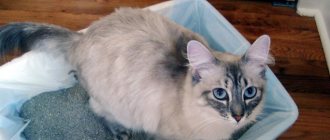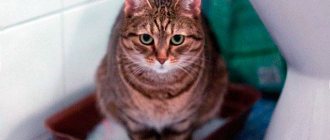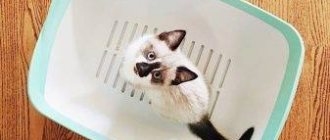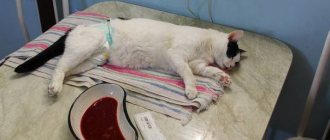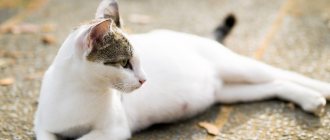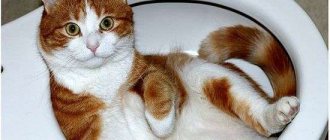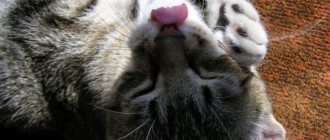You made a mistake during the learning process
You cannot force a kitten to go into the litter box. Any methods of punishing a kitten will be ineffective if the animal that has gone the wrong way is spanked, scolded, or poked with its muzzle into a puddle or pile. The innate quality of a cat is the desire to relieve itself in the same secluded place. Therefore, the process of training a kitten requires observation and a lot of patience. Harsh methods of coercion and punishment are unacceptable.
If the owner does this, the pet will choose a time, a place, hide and take revenge. Expert recommendations boil down to the fact that you should be especially attentive to the kitten after feeding, since the animal tends to go to the toilet after eating. At this time, you need to show him where the tray is located. Under no circumstances should you force him to sit in the tray, press on the sacrum, or dig for litter. With a patient, non-aggressive attitude, the kitten will definitely understand what is required of it.
If a small kitten appears in the house, then it is important to understand that this is not just an animal, but a new family member who also requires attention and needs care. This is exactly what is worth talking about in more detail. The toilet issue is paramount.
Very often, cat breeders are interested in the question of why some kittens flatly refuse to go to the litter box to relieve themselves. They mark the territory wherever they can, but for some reason they ignore the specially designated place in every possible way. In fact, there may be several reasons for such unauthorized behavior, and any kitten owner should be aware of them. First of all, it’s worth clarifying the following fact: when such a fluffy little ball gets into a new home, for the first few days he doesn’t go to the toilet at all, so to speak. Most likely, this is due to stress during the move, or a new unfamiliar environment. In any case, a small pet first needs to get used to it a little, and sniff everything, and only then do its “dirty deeds”.
Any cat breeder should understand that it is simply impossible to instantly accustom an animal to a litter tray, since such babies have certain difficulties with education and understanding. But instincts work excellently, which is why by regularly placing a kitten in a litter tray, you can achieve some success. Within a few days he will understand what exactly this strange man wants from him.
However, sometimes the question of why a kitten does not go to the toilet has a more serious explanation related to the health of the younger family member. It is possible that the baby has constipation, which is usually caused by poor nutrition, stress, and poor bowel function associated with the age characteristics of the kitten.
The tray should be in one place, and moving it around the apartment will only confuse the kitten, and it will take longer for him to learn to relieve himself in one place. When training an animal, it is important to demonstrate all the rigor and perseverance, otherwise there will be no result.
If a kitten does not poop for a long period of time, then this is the fault of the breeder or a young cat who simply does not know how to properly care for her offspring. If a kitten is artificially fed and separated from its mother almost from the first days of life, then the owner’s task is to independently massage its abdomen in order to normalize the digestion process. This is not difficult to do, the main thing is to be careful so as not to harm the health of the little lump.
To prevent such health problems in the future, it is recommended to review the cat’s diet, as well as save the animal from stressful situations in the future. When all preventive measures are completed and observed, then such a piquant trouble can be forgotten.
As mentioned above, in a new home, a kitten may not go to the toilet for up to five days, which is associated with a change of environment and a new home. There is no need to panic at first, but the problem becomes global already on the sixth day. If the kitten also has a tight stomach, then this eloquently indicates that the animal is suffering from constipation. In such situations, you should react immediately, and to alleviate the condition and defecation, stick a small piece of soap in his butt.
This is a win-win option that allows the baby to relieve himself within a few minutes. However, it is better not to allow such a state of the digestive system to occur, otherwise constipation may become chronic.
If your kitten has recurring constipation, it wouldn't hurt to take him to the vet. A competent specialist will not only select treatment, but also find an explanation for this common problem in a particular case. In general, there is no need to worry, because kittens’ digestion does not yet work like a clock.
If the kitten has no problems with bowel movements, but he shits in all places, then it is urgent to understand what is the cause of the problem and find ways to quickly solve it. For example, some kids did not like the tray itself, and they categorically refuse to go into it. Others are distracted by foreign smells, and still others have completely found a cozy place for themselves and are ready to go to the toilet only there. No, things won’t work like that, because very soon a specific smell will begin to spread throughout the apartment, which will not only upset the hostess, but also scare away all the guests. In such cases, it is important to punish the kitten, and to do this, use a newspaper, but in no case a slipper or a belt. In addition, it is recommended to place the tray in the exact place where the ill-mannered kitten relieved itself. When he gets used to going to the litter box, you can simply move him to the toilet. Over time, the situation will normalize, and the animal will get used to finding its place by smell. It is important to remember that the place where the baby shits must be properly treated with special household chemicals, vinegar solution or antigasin. You need to do your best to remove the smell in order to go to the toilet again, the kitten had no thoughts. In general, training an animal to use a litter tray is not at all difficult; the main thing is to act as with a small child: praise for the right actions, and scold and punish for the wrong ones. After just a couple of weeks, the problem with the toilet will be solved; the main thing is not to forget to leave access to the room in which the tray is located.
In conclusion, we can only add that the appearance of a four-legged friend in the family should be conscious, because a small kitten becomes a full member of the family. the breeder must constantly monitor his health and, if necessary, provide medical assistance.
Source: www.8lap.ru
Similar articles:
Random facts from the life of cats and dogs
Frequent washing of a cat is explained not only by the cleanliness of the animal, but also by other purposes. In particular, in this way the cat licks from the fur the required amount of a substance containing vitamin B and necessary to regulate the animal’s mental balance. If the cat is not allowed to do this, it will become very nervous and may even die from stress. - facts about cats
The place for the tray is not secluded
For a cat, going to the toilet is a very important and intimate ritual. The tray must be placed in such a place that the kitten does not feel prying eyes when relieving itself. An animal sitting on a tray may be frightened by conversations, laughter, noise, or the curiosity of children or a dog. Therefore, the kitten’s latrine should be secluded and inaccessible to children and other animals. For this purpose, many people make a special hole in the toilet door or buy a closed toilet for cats. However, the easiest way is to explain to your household that you should not chase your cat when it goes to the toilet. You also need to teach the dog not to approach the kitten's litter box.
Litter tray is not suitable for kitten
As you know, cats hide what they did after going to the toilet. However, if they don't like the filler, they can walk away from the tray. When a kitten has just been purchased, you need to check with the seller what kind of litter the animal is accustomed to. Some breeders use trays with bars, without filler. Others use silica gel, bentonite clay or sawdust. There are fillers with a strong aroma, which can also scare away the kitten. For cats, everything is individual. Only attention, patience and love will help the owner choose the best option for the pet.
Causes of constipation in kittens
Often, constipation in a small kitten is associated with a transfer to artificial nutrition, for example, if the cat has lost milk or has problems with lactation. Also, a baby may have problems with bowel movements if an inexperienced mother does not stimulate (insufficiently stimulate) bowel movements.
A one-month-old kitten's diet often changes. The baby eats not only milk, but also adult foods. Therefore, 1 month is a fairly critical age for digestion. Adding natural food or dry food may cause difficulty in defecation. Insufficient moisture in the diet can lead to the same result.
For a baby two months old, the diet expands even more; kittens are given vitamin supplements. In addition, at 2–3 months, kittens lead a very active life and play a lot. While playing or exploring their surroundings, babies can swallow small objects that block the intestines or simply make it difficult for stool to pass.
A fairly common cause of constipation in long-haired kittens can be hair in the stomach. By licking thoroughly, the baby can swallow hairs, which form in the digestive tract into dense lumps and make it difficult to empty.
Constipation in some cases can be caused by helminthic infestation. For a small animal, parasites in the intestines can become a serious problem.
How to tell if a kitten is constipated
It is quite easy for an attentive owner to notice problems with bowel movements in a pet. The following signs and symptoms are typical for constipation:
- absence of stool for more than two days;
- large belly, dense, often swollen;
- feces in very small quantities, hard, with a strong odor;
- restlessness, frequent and painful meowing;
- regular false urge to defecate.
One or more of these symptoms should alert the owner.
The cat is going through puberty
Another reason why a kitten does not want to go to the litter box is the onset of puberty. It occurs between 6 and 12 months of age. At this time, you may find that the walls, furniture, clothing and other items in the house are splashed with your pet’s urine. Sometimes odor marks appear as large puddles throughout the house. Both male and female cats leave such signs. Therefore, if the owner does not plan to become a cat breeder, experts recommend spaying or neutering a young animal under the age of 1 year.
Kitten is stressed
Many cats react very nervously to any changes. They do not like moving, changing furniture, or repairs. They have a hard time with the arrival of new people in the house. For pets, having a baby can be stressful. In this case, you shouldn’t be surprised when puddles appear in unexpected places throughout the house. This only means that the kitten is stressed, he is marking his territory and defending himself. He should not be punished for this, but it is better to show him to the vet so that he can prescribe sedatives. This will help the cat recover and adapt to new living conditions.
Source
The kitten cannot go to the toilet
Little kittens do not go to the toilet on their own for more than 3 weeks after birth. The motor muscles of the baby's genitourinary system are not yet formed. The mother cat stimulates the elimination of urine and feces with a massage, licking the kittens' perineum and tummy. When the baby is one month old, he begins to urinate on his own 7-9 times a day. As you get older, the frequency of urination decreases up to 3-5 times.
Need to know ! If an animal does not go to the toilet for a day, its body begins to smell unpleasant. Contact your veterinarian immediately.
Causes of urinary retention
The causes of the disease include colds, congenital anomalies, pathologies, and mental disorders.
Urinary retention is classified as:
- acute – complete cessation of urination, requires immediate medical intervention;
- chronic - urine is excreted in small portions, the bladder is not completely emptied.
Acute delay appears:
- in males – with prostatitis, prostatic hyperplasia;
- in females - with ectopic pregnancy, uterine prolapse.
The outflow of urine is impaired if the spinal cord and brain do not regulate the work of contractile muscles. This happens with spinal injuries, strokes, and spinal hernias. Males are more likely to suffer from this disease.
Reason 1. Urolithiasis
In animals, stones form in the urinary system - uroliths, oxalates. They close the urethral ducts, leading to the inability to urinate.
What to do?
Sometimes diseases whose symptom is constipation can be accompanied by other diseases.
Treatment of a disease whose symptom is constipation can only be prescribed by a doctor. Carrying out examinations on your own at home is problematic and not always effective. But you shouldn’t panic because your pet is unwell either.
What should the owner do first:
- Analyze the cat’s nutrition and behavior over the last 2-3 days. Constipation may have been caused by overeating or eating unwanted foods.
- Feel the stomach. Do not press too hard. Pay attention to the animal’s reaction: does palpation cause pain.
- Give more water, stop feeding.
- If constipation occurs after surgery, go to the hospital without delay.
After analysis and determination of the severity of the symptom, it is prohibited to give any medications. Only a veterinarian can make a final diagnosis, as well as prescribe additional examinations (x-rays, ultrasound examinations, urine tests).
Helping adult cats
Adults may be prescribed enemas with the addition of oil and take laxatives. Directions, purposes, and the name of the drug are prescribed by the veterinarian. Unauthorized use is dangerous for the health and life of the cat and can provoke a worsening of the condition.
Help kittens
If a problem stool is detected in a kitten, its diet, quality of drink and food are analyzed.
If a problem stool is detected in a kitten, its diet is analyzed
The maximum assistance that the owner can provide during a pre-medical examination:
- light massage of the kitten's belly;
- starvation diet;
- drinking plenty of fluids.
If the kitten’s condition worsens or stool does not normalize, urgently seek help from a veterinary clinic.
Important! Do not attempt to treat an animal without the appropriate instructions from a doctor with dosage forms intended for an adult or child.
Enema appointment
Significant results are achieved by using an enema. The method is simple, but it is better not to use it without some practice. The first time is done by a veterinarian.
How to give an enema to a cat with constipation
For the procedure you will need a syringe without a needle and Vaseline oil, chamomile, water. Chamomile decoction can be replaced with saline solution.
Be sure to read:
How many times should a cat go to the toilet, small and large?
How to perform an enema:
- Prepare chamomile decoction or saline solution at the rate of 1 tsp. chamomile or salt per 1 glass of water.
- Give cats a small amount of Vaseline oil 1-1.5 hours before the enema.
- Lubricate the tip of the syringe (the place where the needle is connected) with Vaseline and sunflower oil. Gently insert into the anus. If you have a syringe, the insertion depth should not exceed 1.5-2 cm.
- Pinch the anus with your tail. Keep the animal in your arms in this state for a quarter of an hour.
What to do at home if your cat is constipated?
Significant results are achieved by using an enema.
Douching as a method gives a positive result. But cats don’t like it, as they experience pain during the enema.
Also, frequent use of a syringe as an aid has the opposite effect: the intestines stop functioning normally, and in 75% of cases the procedure provokes the appearance of ulcers.
It is strictly forbidden to use douching if:
- pregnant cat;
- the animal suffers from cardiovascular diseases;
- blood clots and bleeding were noticed;
- there are violations of the integrity of the skin in the genital area.
Important! It is dangerous to resort to self-treatment if frequent constipation occurs.
Some funny cats
The development of the disease is promoted by:
- genetic predisposition of the breed;
- dehydration;
- sedentary lifestyle;
- unbalanced diet;
- increased levels of calcium in the blood.
When urine obstruction begins, animals begin to urinate frequently in small portions. When complete abstruation occurs, the urethra is blocked, the kitten cannot go to the toilet.
Urolithiasis often develops simultaneously with cystitis, because sand and stones injure the mucous membrane of the ducts, causing an inflammatory process.
Need to know ! The following should be excluded from the diet of animals with a predisposition to urolithiasis:
- fish - phosphorus promotes the formation of stones;
- raw meat thickens and urine is more difficult to excrete;
- milk – contains magnesium, which prevents the flow of urine.
Animals are fed food with a high content of vitamins A, B, and glutamic acid.
Reason 2. Anuria
In kidney failure, organs lose their ability to produce urine. The acid-base metabolism and water-acid balance of the body are disrupted, which leads to intoxication.
Kitten can't go to the toilet
Until the kitten is one month old, the mother cat stimulates the process of defecation by licking. By the end of the 4th week of life, the baby’s intestines are formed, the diet becomes more varied, and feces are formed. The kitten goes to the toilet on its own 2-3 times a day.
After one year of age, the animal defecates 1-2 times daily. If this does not happen, it means that the pet is developing a gastrointestinal disease or other pathology. Intoxication begins, the kitten becomes dull, hair falls out, and the skin becomes covered with a rash. Peristalsis is affected by the kitten's nutrition, activity, and a number of diseases.
Kitten less than 3-4 weeks old
Until 3 weeks of age, kittens are not capable of independent urination and defecation - the mother cat stimulates these functions by licking the kittens' genital area. This problem often arises with selected kittens left without a mother for some reason. In this case, the problem can be solved quite simply: after each feeding, it is necessary to massage the area of the kitten’s anus and genitals with a cotton pad moistened with warm water for 20-30 seconds so that the kitten can go to the toilet. This, of course, is not the most pleasant procedure, but it is vital for very young kittens.

